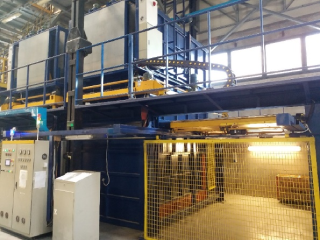Overview
Principle
General
Chemical Strengthening Of Glass Is Done By Chemical Ion Exchange Reaction Inside A Tank Bath Filled With Potassium Salt & Special Catalyst

The major structure of the system is a chemical bath tank filled with potassium salt added with some special ingredients which act as catalyst. Chemical strengthening is the name given to glass products that have been strengthened by means of an ion-exchange process. It is a surface treatment which occurs at a temperature lower than glass melting temperature. Glass to be treated is submerged inside the bath of melted potassium salts. Chemical ionic exchange is taken place between superficial sodium ions in the glass and potassium ions inside the bath. The process parameters such as ion exchanging time and temperature would be modified according to the type of glass to be treated and the required strengthen specification. This process increases the thermal and mechanical strengths of common annealed soda lime silicate glass without affecting its optical properties. Chemical strengthening is particularly useful for thin glass, tiny glass and shape glass which cannot be tempered by ordinary physical tempering.
Ion Exchange
It Is A Chemical Process of Position Exchange Between Alkali Ions Of Glass & Potassium Ions Of Salt
Alkali ions (usually Na+) in the glass matrix are exchanged for other larger size alkali ions (usually K+) in the molten salt matrix. Potassium ions of salt and sodium ions of glass are exchanged.
Sodium ions are small while potassium ions are larger. During ion exchanging, sodium ions detach from glass and meanwhile, potassium ions migrate into the glass and replace the original position of sodium ions. Larger potassium ions try to hustle into smaller spaces left behind by sodium ions. This causes sodium ions in the glass surface to be replaced by potassium ions from the bath solution.
The cycle time would be greatly reduced if the glass is made of certain elements such as lithium because ion mobility between potassium and these elements is a lot faster.
Induce Stress
Stress Is Induced On Glass During Ion Exchanging
The introduction of potassium ions which are larger in size than the sodium ions at certain temperature results in the establishment of a system of residual stress characterized by compression stretches on the surface counterbalanced by traction stretches within the glass. During cooling, potassium ions on surface shrinks little while sodium ions in inner shrinks larger. Hence, stress is induced between glass surface and internal body and consequently, the glass is strengthened. The internal glass network cannot relax because the chemical ion-exchange process is performed below glass transformation temperatures range. Residual stress on glass surface is then generated. This results in a highly compressive stress in the near surface region and in a weak tensile stress in the inner part of the glass. Consequently, glass mechanical and bending strength and thermal stability as well are increased while remaining optical property unchanged. In chemical tempering, the glass surface stress is higher in comparison to thermal temper glass, while the traction stress which occurs within the glass is lower.